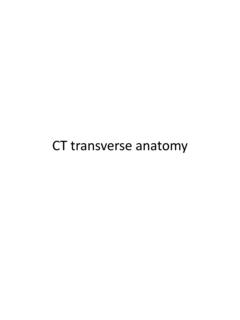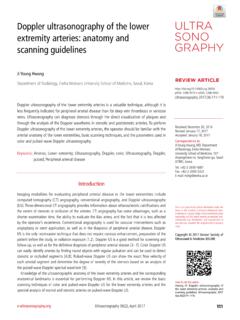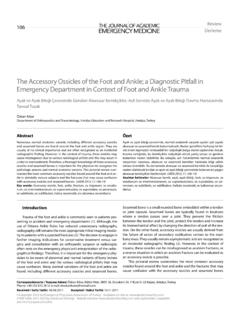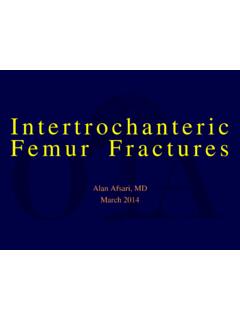Transcription of LIMITED ABDOMINAL ULTRASOUND EXAMINATION …
1 LIMITED ABDOMINAL ULTRASOUND Protocol 1. Revised: 8/28/2017. LIMITED ABDOMINAL ULTRASOUND EXAMINATION . (Right Upper Quadrant or Left Upper Quadrant). POLICY: LIMITED ABDOMINAL ULTRASOUND will be performed with an order from a physician or other qualified clinical practitioner. The EXAMINATION will be supervised and interpreted by a radiologist or other licensed practitioner who is qualified by reason of training to understand the normal anatomy, pathophysiology of the abdomen, and integration of ULTRASOUND with other imaging techniques to optimize the probability of detecting disease. PURPOSE: To assess the anatomy of the abdomen and document normal and abnormal structures therein.
2 INDICATIONS: LIMITED ULTRASOUND of the abdomen is indicated for patients with signs, symptoms, and/or laboratory evidence of hepatic, biliary, splenic, and/or enteric disease. This targeted EXAMINATION is an appropriate study for patients with more specific ABDOMINAL complaints. Note: A liver focused LIMITED ABDOMINAL exam should be performed when the primary indication is specific to the liver (hepatitis, elevated LFT's, etc.). Please see protocol Abdomen LIMITED Liver (Elasto) US Protocol for details regarding requirements for a liver focused LIMITED ABDOMINAL exam. PATIENT PREPARATION: Outpatients should be fasting for a minimum of eight hours prior to ABDOMINAL ULTRASOUND of the abdomen.
3 Sips of water are permitted. Non-urgent inpatients should be fasting for at least six hours if possible. Emergency Room and acute patients may be examined without fasting. Patients should be instructed to take prescribed oral medication on their normal schedule. The preparation for patients receiving diabetic medication (oral or injectable) must be approved by the radiologist or nurse. PROCEDURE: Each organ should be imaged in its entirety ( longitudinal and transverse views). When an image is captured with measurement(s), a duplicate image should be saved without measurements. Images should be archived in the following order (minimal number of images in parenthesis excluding duplicates): Right Upper Quadrant Liver (15 images).
4 Gallbladder(6 images, 1 cine sweep). Bile duct (6 images). Right kidney (3 images). Left Upper Quadrant Spleen (3 images). Left kidney (3 images). LIVER: The liver should be examined to investigate the entire contour, size [1], intrahepatic vascular and ligamentous anatomy [2,3], and parenchymal pattern [4,5]. The EXAMINATION can be performed in supine or decubitus positions, with respiration suspended at a level that optimizes images of the desired anatomy. The anterior subcostal approach should be employed when it feasible to do so. An intercostal approach can be used as an alternate or supplementary window when necessary. LIMITED ABDOMINAL ULTRASOUND Protocol 2.
5 Minimal stored images should include (appropriate image labeling in italics): Long Liver o Rt lobe x4 sagittal (Rt-Lt). Measure: maximal cephalocaudad length (diaphragm to its inferior tip) in a parasagittal plane dome right kidney to allow parenchymal echogenicity comparison inferior margin short axis main portal vein o Lt lobe x3 sagittal (Rt-Lt). inferior vena cava caudate Trans Liver o Lt Lobe x3 transverse lateral contour left portal vein ligamentum teres / round ligament o Rt lobe x6 transverse dome hepatic veins long axis main portal vein long axis main portal vein - Color Doppler patency & flow direction lateral margin right portal vein right kidney In the presence of cirrhosis, the patient is at risk for hepatocellular carcinoma (HCC).
6 Therefore, when examining a patient with chronic hepatitis (potentially undiagnosed cirrhosis) or cirrhosis, the entire liver should be screened for the presence of a liver mass which could represent HCC, and the following image and cines should be obtained: Long Liver Rt-Lt o Rt Lobe x1 sagittal cine Rt lateral margin through the porta hepatis o Lt Lobe x1 sagittal cine porta hepatis through the Lt lateral margin Trans Liver Sup-Inf o Lt Lobe x1 transverse cine superior margin through the inferior margin o Rt Lobe x1 transverse cine dome through the inferior margin Liver Surface Contour o Liver Surface x2 sagittal and/or transverse linear transducer LIMITED ABDOMINAL ULTRASOUND Protocol 3.
7 BILIARY SYSTEM: The gallbladder should be examined to consider stones [6,7], wall thickness and irregularities [8,9], pericholecystic structures, and tenderness to palpation with the ULTRASOUND transducer (Murphy's Sign) [10]. The gallbladder must be examined with the patient in at least two different positions to assess the mobility of intraluminal objects ( gallstones). In the presence of gallstones, multiple positions should be employed in order to differentiate mobile gallstones from gallstones lodged in the neck of the gallbladder. The intrahepatic branches of the bile ducts should be investigated in each lobe of the liver, and the extrahepatic segment of the bile duct examined through its entire course from the porta hepatis to the sphincter of Oddi [11,12], searching for enlargement or intraluminal objects ( stones).
8 Minimal stored images should include (appropriate image labeling in italics): Long GB Supine o x2 longitudinal neck fundus GB wall Long GB LLD (or Upright, Prone, etc.). o x1 longitudinal exaggerated left lateral decubitus, upright, prone/kneeling focused on the most dependent segment Long GB. o x1 longitudinal cine position that optimizes visualization Trans GB. o x2 transverse position that optimizes visualization Long Bile Duct o x2 longitudinal Measure: extrahepatic maximal luminal diameter color Doppler may be utilized to isolate the bile duct from surrounding vessels KIDNEYS: EXAMINATION of the kidneys should be performed to visualize the entire capsule. The kidneys should be imaged in a longitudinal and transverse planes (the transverse plane is perpendicular to the long axis).
9 Observations should include the renal size [18,19,20], contour [21,22,23], intrinsic echogenicity of the kidneys [24], condition of the collecting structures [25], echogenicity of the kidneys relative to the liver and spleen [26,27], and perinephric spaces. Images of the kidneys should be sufficient enough to allow for assessment of the renal cortex, medulla (pyramids), and sinus. If a renal cortical thickness is requested, measurements should be obtained at the superior, middle and inferior regions of the kidneys. The cortex should be measured at the thinnest point, from the peripheral surface of a renal pyramid to the renal capsule. The average value of these measurements should be reported.
10 The kidneys should be examined in the orientation ( sagittal, coronal) and patient position ( prone, decubitus, or supine) that optimizes the definition of the entire renal capsule and maximizes the measured dimensions. LIMITED ABDOMINAL ULTRASOUND Protocol 4. In the presence of a dilated collecting system, the kidneys should be imaged after voiding the urinary bladder in order to demonstrate persistence of the dilatation. Minimal stored images of the spleen should include (appropriate image labeling in italics): two longitudinal views of each kidney with the maximal length measured, labeled Rt or Lt Kidney Long one transverse view of the middle third of each kidney with the maximal anteroposterior and transverse diameters measured, labeled Rt or Lt Kidney Trans one longitudinal view of the each kidney, with sufficient volume of liver or spleen, to allow comparison of the relative echogenicity of those organs to the kidneys, labeled Rt or Lt Kidney Long (if imaging of the liver and/or spleen has already satisfied this requirement, then additional images are not required).






